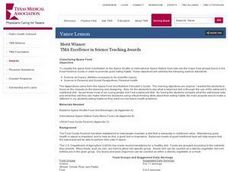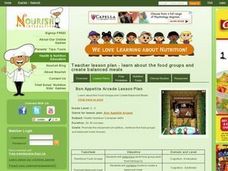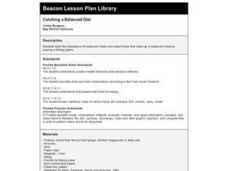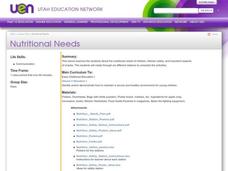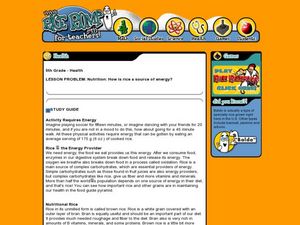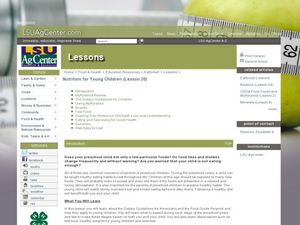Curated OER
Animals, Soil, Trees
Fourth graders describe the various kinds of soils and how plants and animals are affected by them. They describe the baic needs of plants, scoring at least a 3 or 4 on a 4-point rubic. Students are able to predict and/or infer what...
Curated OER
Starches, Fats And Sweets, Oh No!
Students log their food intake for one week and analyze their diet using the food pyramid. They then design a week of nutritional meals and snacks for a young child that they might baby-sit.
Curated OER
Book Box
Students create a bookmark, book cover and book review for a book they read. In this nutrition meets literacy lesson, students read a book about food and complete creative projects based upon the book. Some of the ideas included in this...
Chicago Botanic Garden
Leaf Litter Ecology Lab
Some organisms spend their entire lives in leaf litter. The third in a series of six is a great lesson exploring the community of leaf litter. Groups gather and then spread leaf litter over white paper and remove leaves/twigs while...
Curated OER
Learning About My Eating Habits
Learners explore their own dietary habits and identify food pyramid guidelines including serving sizes and recommended portions. They complete worksheets, conduct Internet research and evaluate school lunches.
Curated OER
Classifying Space Food
Students write a written summary of what they have learned about the astronaut nutritional diet in comparison with their own diet habits.
Curated OER
What's The Idea
Students discuss the importance of identifying the main idea in reading selections. After reading newspaper articles related to nutrition, students identify the main idea of the selection and three supporting details. A reading log...
Curated OER
Diet: Soup and Salad Lab
Students prepare soup and salad meals and assess their nutritional and aesthetic values. After solving soup riddles and discussing types of salads, they use meal planning forms to list ingredients and recipe information. The lesson also...
Curated OER
Simple Steps to Healthy Living
Young scholars observe a video on eating habits, discuss their own habits, and then create their own food pyramid. In this research lesson students go to a webpage and enter their personal information then they get a food pyramid...
Curated OER
Nutrition and Body Image
Students study nutrition and how to maintain a healthy diet. In this adolescent nutrition instructional activity students complete several activities that allow them to see different nutrition scenarios.
Curated OER
Bon Appetite Arcade Lesson
Students research nutrition by examining the food pyramid. In this culinary lesson, students identify the concept of a balanced meal by researching the different groups on a food pyramid. Students utilize the web to play a game titled...
Beacon Learning Center
Catching a Balanced Diet
First graders explore the importance of balanced meals. They play a fishing game to help them select foods to make up a balanced meal.
Curated OER
Nutritional Needs
Students complete work at six stations as they investigate children's nutritional needs, kitchen safety, and snacks. First, they listen to Dr. Seuss', "Green Eggs and Ham" before discussing nutrition and the station activities. At each...
Curated OER
Rice as a Source of Energy
Fifth graders investigate the nutrition in rice. In this rice lesson, 5th graders discover that rice is a great source of energy. Students compare foods to rice to see the differences in the nutritional value. Students classify foods in...
Curated OER
Pond Ecology
A lab activity is a great way to incite thoughtful questioning and scientific processes. Pupils will collect organisms with a Petri dish, make observations, sketch the organism, ask questions, then attempt to identify the specimen...
Curated OER
Meal Planning and Nutrition
In a home environment, learners with special needs practice creating nutritious meal plans. They talk about healthy food choices, then use the food pyramid as a guide to planning three balanced meals. They use a food group check sheet to...
Curated OER
Nutrition for Young Children
Students examine the dietary guidelines for young children. In this healthy diet lesson students examine the issues surrounding the children's diets.
Curated OER
Description and Modifying: What's On Your Plate?
Young scholars create a food product and an advertisement promoting it. In this description and advertising lesson, students read children's book for inspiration and discover advertising techniques. Young scholars complete their ads...
Curated OER
The Brown Rice Bonus
Students investigate how brown rice can be incorporated into a daily healthy diet. They practice preparing and storing the rice in the most beneficial ways. Also goals are set to increase the consumption of it in the dose of twice a week.
Curated OER
Cloudy With A Chance of Meatballs
Second graders explore weather. In this weather lesson, 2nd graders read Cloudy With A Chance of Meatballs and participate in four supplemental science activities. Students participate in Internet research, create weather maps,...
Curated OER
Biology: living Things and their Environment
Middle schoolers recognize that organisms depend on other organisms. In this organism lesson, students understand symbiotic relationships and competition. Middle schoolers explain food chains and food webs. Students understand that...
Curated OER
Eating and Being Healthy
Students investigate healthy lifestyles by examining the food pyramid and performing physical activities. In this personal health lesson, students discuss their own diets and how it compares to the food pyramid. Students participate in...
Curated OER
Why is Rice Good for Us?
Third graders explore why rice is good for our bodies. In this nourishment lesson, 3rd graders review the food pyramid and discuss serving sizes. Students discuss the different ways rice is used in food. Students use uncooked rice to...
Curated OER
Family Life Cycle
Learners review the food groups and their placement on the food pyramid. Using the internet, they research the nutritional guidelines for different age groups and compare them. To end the lesson, they identify reasons for choosing the...







